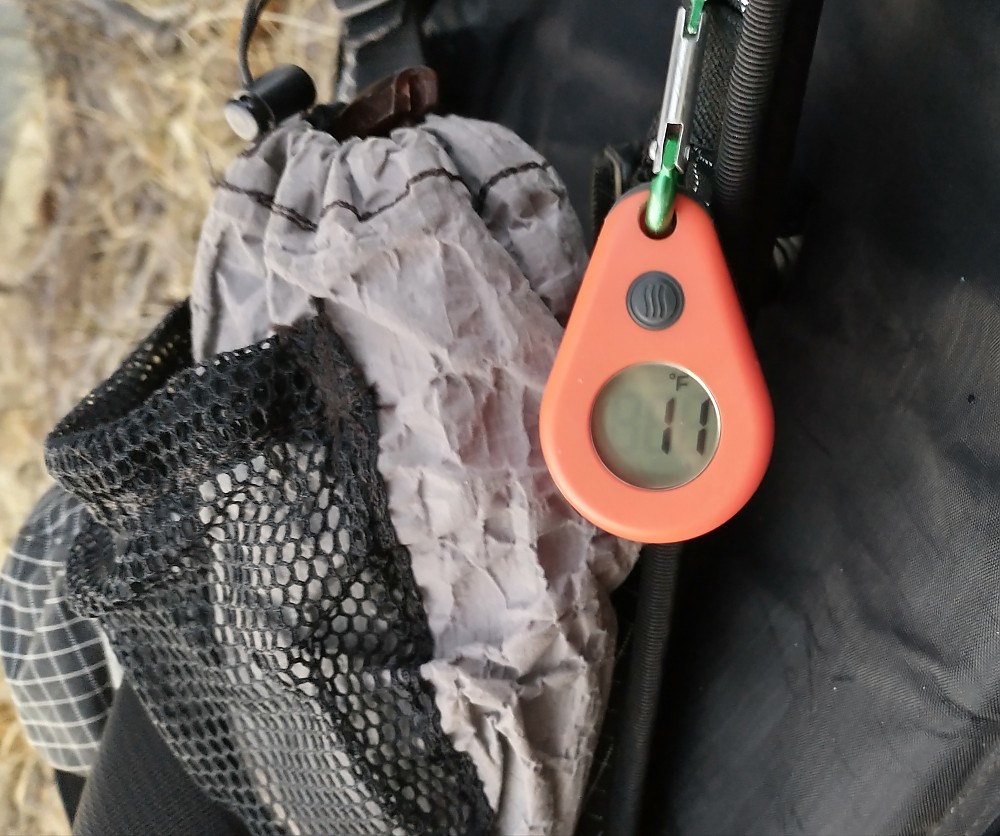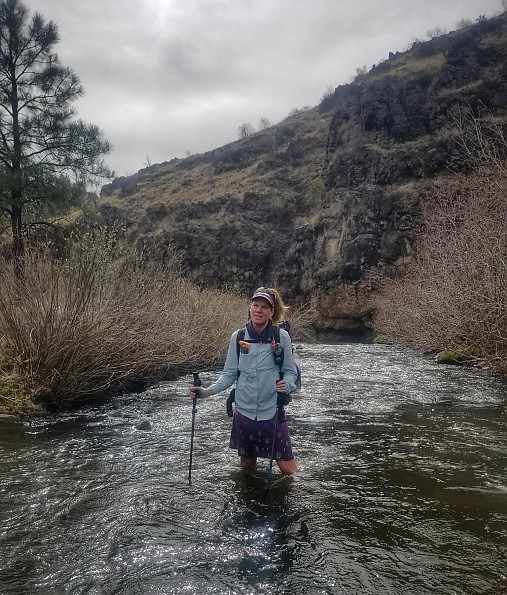ThermoWorks ThermoDrop

The ThermoDrop is a key-chain or zipper-pull digital thermometer that's useful for gathering temperature data in the backcountry. Such statistics help me in better understanding my tolerances and gear needs. It's also fun for bragging rights/telling stories about my backcountry adventures.
Pros
- Records daily min & max temps
- Small
- "Relatively" inexpensive
- Lightweight at 0.5 oz
- Easily attaches to things
- Easy-to-read digital display, rotates and has a backlight
- Wide temp tolerance
- IP67 weather resistant
- Helps a hiker better understand their needs for gear and clothing.
Cons
- Can buy a simple mercury thermometer for much less.
- It takes a minute or so to adjust.
- Sensor can be affected by body heat or being directly in the sun.
- Only a few places to purchase online.
- Don't really need it...fun for gear geeks like me.
Background: I'm fond of factual and actual numbers when it comes to backpacking. There's just so much that's subjective and tailored to individual needs and perspectives, especially when it comes to temperature ratings and ranges. There have been many times when I felt exceptionally cold or hot but wondered, were the ambient temperatures really that extreme? Wouldn't it be helpful to know the exact temperature at any given time or how cold it really got overnight?
There are watches and phones that claim to be able to record temperatures, but I never trusted the readings. Such devices are subject to inaccuracies, either from being in proximity to body or battery heat. Can they also record min/max data?
The ThermoDrop is a simple stand-alone thermometer that's lightweight, small, but also accurate and able to capture historic (overnight) data. It's available at a reasonable price-point (though it would be even better if it cost a little less).

ThermoDrop Features & Specs:
- Big, backlit digits w/ Auto-Rotating Display
- Range from -13 to 122°F (-25 to 50°C)
- Switchable °C/°F readout
- Water Resistant: IP67 stands up to light rain, splashes or spills
- Records Max/Min: how cold it got overnight or the highest temp you’ve experienced during the day...must hold button 5 seconds to power off and back on to reset daily recordings, otherwise it will only record the min/max for the whole trip/time it's turned on.
- Dimensions: 49 H x 33 W x 12.5 D mm
- Accuracy: ±1.8°F (±1°C)
- Backlight: 10 seconds
- Battery: 1 CR2025 (3V) lithium coin cell, approximately 4000 hours (167 days)
- Display: 18.2 dia. mm; Digits: 7.45 H mm
-
Weight: 0.5oz | 14.3g
Notes about the operation:
There is only one button to press. The press/hold sequences are fairly intuitive (i.e. one can mostly stumble upon all the features without remembering the instructions).
 As one reviewer stated, there should be more time between entering the min/max readings and the device turning off. It's possible to try to see the min/max data, only to inadvertently shut off the device, thereby resetting the data.
As one reviewer stated, there should be more time between entering the min/max readings and the device turning off. It's possible to try to see the min/max data, only to inadvertently shut off the device, thereby resetting the data.Additionally, the device can take up to a minute or so to adjust to ambient temperatures. Like any thermometer, it's going to read high if subjected to direct sunlight. I also notice the temperature going up a few degrees when I handle it briefly to press the button.
Conditions: I've been using a ThermoDrop for the past year on thru-hikes of the Mogollon Rim Trail (MRT, Arizona and New Mexico) and Pacific Northwest Trail (PNT, Montana, Idaho, and Washington). I also used it on a Continental Divide Trail section hike to 14K' and an Appalachian Trail section hike. I plan to keep it attached to my pack going forward, simply because I get a kick out of always knowing the temperature.
Such information has really helped me better understand my temperature tolerances. Not only does this aid me in gear choices, it can also alert me to when I'm not doing well. Sudden intolerances that are outside the norm or the inability to thermoregulate can be signs of a problem...not enough rest, nutrition, water, etc. When traveling in remote and rugged places such as the desert southwest, it's good to pay attention to this kind of information...especially if it only comes at the cost of half an ounce.
Here are a few examples of how the ThermoDrop is helpful and interesting in calibrating my understanding of temperatures and gear:
I hiked the Grand Enchantment Trial (GET) the year before I hiked the MRT (both are similar routes that were invented by Brett Tucker, utilizing existing dirt roads, trails and cross country travel in Arizona and New Mexico). My hiking buddy and I experienced some really cold nights on both trails. The best indication of this was that our water bottles were partially or completely frozen some mornings. One might assume that this means the temps were just below freezing. But what I've learned over time, thanks in part to the ThermoDrop, is that when water bottles actually freeze solid, temps are closer to the low 20's or even well into the teens. I've also observed that the temperature inside my tent can be as much as 10 degrees F warmer than outside...I always knew this as a general rule, but it's useful to put numbers to it.
We experienced plenty of cold nights on the MRT, but at least this time had actual data to compare with. During a series of nights in the mid to low 20's, we got really crafty about our site selections each night. Pitching behind wind-breaks and under dry trees makes a HUGE difference, so anything that aids and encourages advanced backcountry knowledge is a good thing! It can mean the difference between suffering all night inside a quilt that's right at its range limit versus being warm enough.
Though one night, we got it very wrong. I could feel the biting cold as soon as the sun set. We'd chosen a partially-burned area, which was a mistake (not that we had much of a choice since we were in the largest burn area in all of AZ). Even though the forecasted low for the nearby (2 miles) town of Greer was only 29F, my ThermoDrop was already reading 30F when I went to bed at 8 pm. This prompted me to break 2 chemical hand warmers (my emergency hack for really cold nights). I tossed and turned a bit overnight, having that awful feeling of the cold sneaking in. But at least I didn't get to the point of shivering and not being able to sleep. Imagine my surprise to find that it was 15 F degrees inside my tent and 11 outside in the morning! Yes, I'm raising my hand at bringing a 22-degree quilt to an 11 degree party...but who knew it got so cold in Arizona in April? But of course it does. Real numbers are what count, not forecasts.


76F ...sweet!
Construction and Durability: The ThermoDrop is a pretty durable and simple device that does one basic thing. It comes with a cheap split-ring, which didn't bother me other than the fact that it was a bit of a pain to remove. I had a bunch of cheap biners to substitute. A cord or ziplock could work for attaching it to things too, though I worried about losing it this way.
My battery started dying in the fall of 2022, so I estimate that it made it through about 5 months of use. This is consistent with the published specs. The battery was easy to replace. I also appreciate that the ThermoDrop has an on/off switch, something that its most closest competitor, the AcuRite 00318 Suction Cup Digital Thermometer, does not have. That thermometer is half the the price and more readily available from major online retailers. But it's also larger and twice the weight. The ThermoDrop can be purchased directly from ThermoWorks or also on Garage Grown Gear (a personal favorite source for small-brand gear... I have no affiliation).
Lastly, while it would be wise to not subject the ThermoDrop to a dunking while crossing a river, it's also not such a critical or costly item that I worry about protecting it from the elements. It just hangs on my pack and does its thing.

Source: bought it new
Price Paid: $22 USD
Your Review
Where to Buy
You May Like
Specs
| Price |
MSRP: $22.00 Reviewers Paid: $22.00 |
| Range |
-13 to 122°F / -25 to 50°C |
| Accuracy |
±1.8°F / ±1°C |
| Resolution |
1° over full range |
| IP Rating |
IP67 |
| Backlight |
10 seconds |
| Battery |
CR2025 (3V) lithium coin cell (included) x 1, approximately 4000 hours (167 days) |
| Display |
18.2 dia. mm / 0.71 dia. in |
| Digits |
7.45 H mm / 0.29 H in |
| Size |
49 x 33 x 12.5 mm / 1.92 x 1.3 x 0.49 in |
| Weight |
14.3 g / 0.50 oz |



